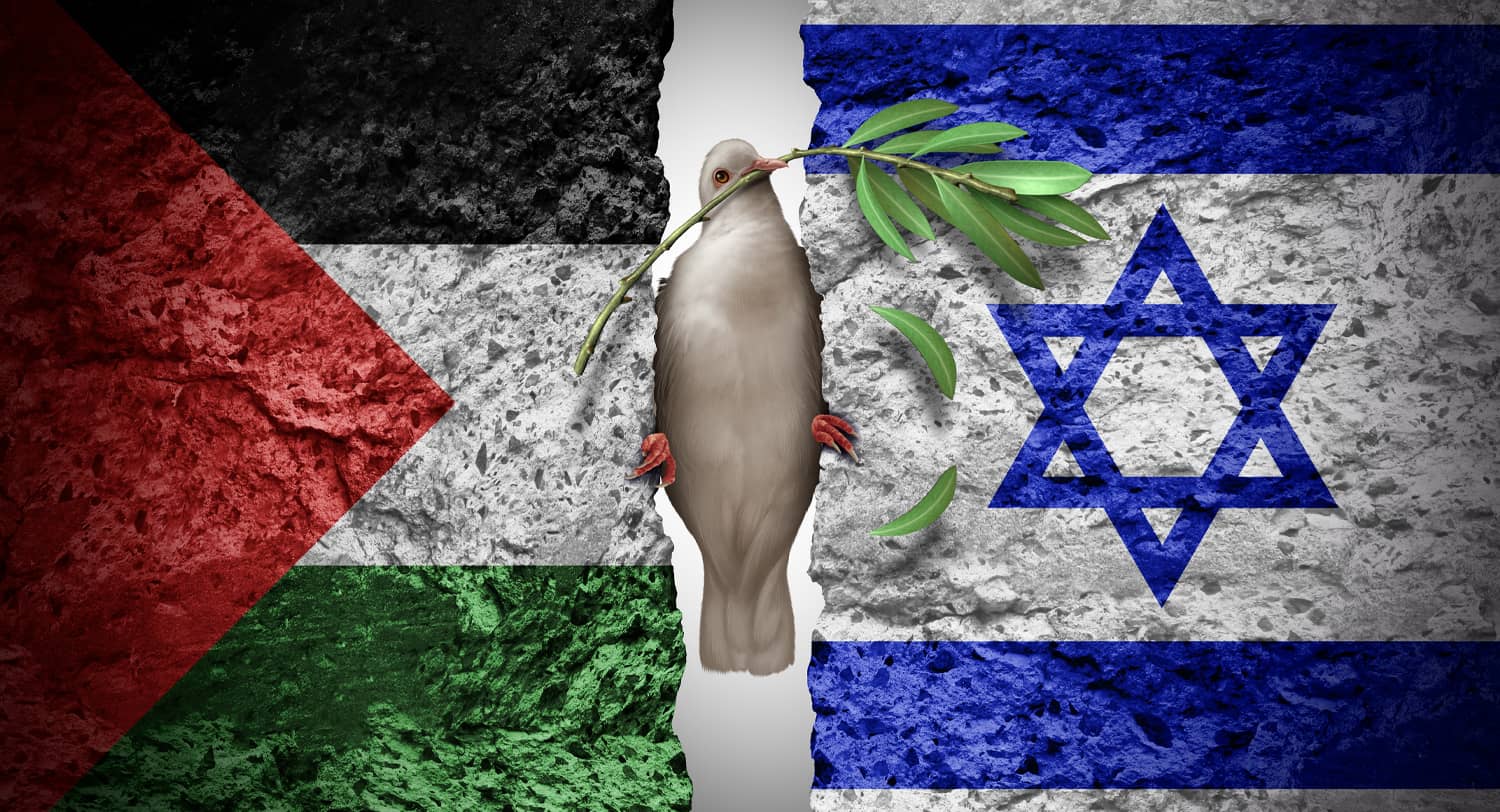Four months after October 7, 2023 I met an Egyptian acquaintance, and we tried to make sense of the situation. He offered the thought that “the two-state solution was never as relevant as it is now. Everyone understands that the Palestinian issue is back on the global agenda, and it is understood that there is no other solution.”
My impression is different. The two-state solution suffered a severe blow on October 7 and is not about to be realized anytime soon. New temperaments have surfaced in the Middle East – in Israel, among Palestinians, and regionally – that lead me to this conclusion.
The Hamas assault gave Hamas and Iran a shot at eliminating the intermediate step (in their view) of a two-state solution by moving directly to eliminating Israel. And in Israel, the damage done to actual security, and to the subjective sense of security of Israeli citizens, caused Israel as a nation to sober up and to change regarding any future agreement.
Palestinians, Israelis, and regional countries now have an opportunity to “recalculate route” as navigation software tells us, and put together a course of action better suited for achieving a diplomatic outcome and generating stability. So as to bear the burden of a new agreed framework, the wobbly and cracked structure of a two-state solution needs to be closed for renovations. Temporarily, hopefully.
Hamas Reframed the Conflict by Seeking to Undo the Two-State Solution
By launching a war, Hamas and its partners have undermined some of the basic assumptions about the Israeli-Palestinian conflict:
Reframing the conflict as a multi-front regional struggle – Iran has taken control of the Israeli-Palestinian confrontation as part of its effort to build a “ring of fire” around Israel. The war is not just between Israel and Hamas, but rather fought on several synchronized fronts, coordinated by Iran and sustained by terror in the name of Islamist political ideology.
Undermining the narrative of a Palestinian State based on the 1967 lines – Hamas made it clear that it ignores the armistice lines (which held from 1949 until the Six Day War) as a basis for a territorial compromise – and sought to conquer areas beyond them. In other words, the struggle led by Hamas no longer upholds the narrative adopted by the PLO since 1988 and the Oslo Accords, which calls for national self-determination alongside Israel, but rather supplants it with a radical Islamist agenda “from the river to the sea,” terminating the Zionist project and denying Jews their rights. It has thus turned its back on its own policy document of May 2017, which seemed at the time to indicate a willingness to accept a Palestinian state along the 1967 borders, in the context of an internal Palestinian accord (i.e. between Hamas and Fatah). Indeed, Hamas has now driven Palestinian national aspirations not only back to 1948 but rather a hundred years ago, when the purpose (as in the Hebron massacre of 1929) was to butcher the Jews.
The Hamas assault did put the Palestinian question back on the table. But it undermined the conditions necessary for the realization of the traditional two state solution, based on mutual recognition of the right of self determination of both peoples in the land. Hamas demolished the remnants of trust in the Israeli public for the viability of the Palestinian side as a partner, even among the much reduced “peace camp.”
Israel has Sobered Up
Israelis feel they cannot take the risk of a Palestinian state now, since this state would be dominated by Iranian-backed radicals, and by young hotheads leading a desperate population, incapable of governance and responsible behavior. All this amidst growing Iranian pressure on Jordan so as to create an Islamist continuum, and with the international arena potentially offering legitimacy for further Palestinian violence.
Israel must now meet two simultaneous challenges:
A new security concept demonstrating national resilience and making it clear that no assault will break the spirit of Israeli society; restoring deterrence at the regional level, and ensuring a decisive response in any arena Israel is challenged in – no longer relying on containment; preparing for a prolonged conflict with Iran and its proxies, based on a rebuilt IDF capability; rebuilding an ironclad partnership with the United States; avoiding hasty compromises which would be perceived as a prize for ‘Abbas or a reward for Hamas aggression; strengthening a regional coalition to deal with common threats and advance security and economic cooperation.
A brave stance against messianic extremism – taking into account the need to face vindictive sentiments generated by the horrors of 7 October; the growing friction in the West Bank; the aspirations of some in Israel for a one- state solution, based on inequality or deportation; a renewed push to expand settlements, so as to make a future separation impossible; attempts to overthrow the status quo in the Temple Mount Compound; and incitement in the social media against Israeli Arabs.
Peace and the end of conflict may not be realistic goals at this stage, but work must begin to reduce the level of violence and lay a path for a future settlement. Based on this multiplicity of challenges, Israel needs to define new priorities, working at one and the same time to achieve a decisive outcome in battle and to generate a regionally driven diplomatic initiative based on security and de-radicalization.
How to Fix a Broken Concept?
All of the above leads to one conclusion – seeking to establish a Palestinian state right now is frankly dangerous. Instead, three large steps are needed to lead us to a new settlement, which would perhaps have a new name.
New leadership: Both Israel and the Palestinians need new leaders, rather than those who failed in the last 20 years, and missed the many opportunities offered by the prior peace plans advanced. The Palestinians, backed by the pragmatic Arab states, should choose a new leadership that would improve their conditions and work to secure the legitimate aspiration endorsed in 1988.
In Israel, new elections should result in a government of national cohesion, comprising all pragmatic Zionist forces neutralizing the radicals on both sides. It would endorse the revived security concept outlined above, confront extremism, and would seek a diplomatic strategy based on the commonality of interests between Israel and key Arab states, facing Iran, and strengthening the Negev Forum as a platform for security, economic, climate, and de-radicalization cooperation.
New Ideas: These should reflect lessons learned from past efforts – those that failed with the Palestinians, and those that succeeded with other Arab partners. Such ideas would abandon the failed bilateral model, warped by the asymmetry between Israel and the Palestinians, and instead structure a regional role backed by an American commitment. A coherent road map defining accepted goals – right from the beginning – should avoid the pitfalls of incremental projects such as Oslo Accords or the Quartet Road Map.
A change of governance and a massive reconstruction in Gaza are necessary first steps; and gradual implementation is inevitable given the impossibility of creating new realities overnight.
New Options: Given the failure of past efforts, new options, some of which may shatter existing templates, should be considered, including:
Two asymmetrical states: a Palestinian mini-state lacking some aspects of sovereign power – demilitarized, its borders with Jordan and Egypt under Israeli control, with its capital not in Jerusalem, and with the “right of return” applicable to its territory, not to that of Israel. A change of these parameters would be considered in 25 years time, subject to fulfillment of mutual obligations.
Reviving a “Trump Plan 2.0” – with a longer timetable for implementation and without the provision for enlarging the Gaza Strip at the expense of the Negev; and with a regional dimension properly integrated, and tightly linked to negotiation and implementation progress.
Iran First – all regional (and international) parties acknowledge no solution can be achieved and no Israeli concessions can be expected until the Iranian regime and its regional and nuclear ambitions have been effectively dealt with.
An international mandate – under which regional and international countries form an interim regime to govern the West Bank and Gaza for a defined period, leading to a negotiated two-state solution once security, stability and regional normalization have been established.
Mutually coordinated one-sided separation measures – reducing friction between the populations, supported by a regional role and by security arrangements.
This essay is written with a sense of pain over the missed opportunities and the failures of past efforts – logical as they may have seemed at the time, and especially since 2002. What is suggested here would probably be rejected by those on the Israeli left still wed to the old two-state solution, by those on the Israeli center right, who fear the loss of security control, and hard right, who entertain messianic visions. But the center of gravity in Israel should join hands with sober elements in the Arab world and the international community willing to take an open-eyed look at threats and opportunities and build upon what has already emerged in terms of regional security cooperation. It is time to renovate, and time to innovate.
Thanks to Eran Lerman for translating this article from Hebrew into English.

